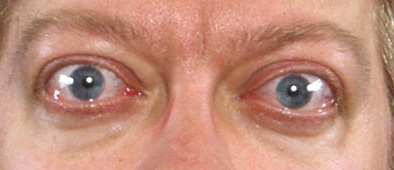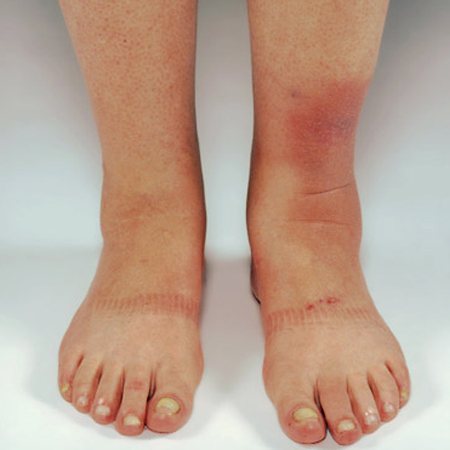Em partes do mundo com quantidades suficientes de iodo, a prevalência de hipertireoidismo evidente é de 0.2% a 1.3%.[11]Taylor PN, Albrecht D, Scholz A, et al. Global epidemiology of hyperthyroidism and hypothyroidism. Nat Rev Endocrinol. 2018 Mar 23;14(5):301-16.
http://www.ncbi.nlm.nih.gov/pubmed/29569622?tool=bestpractice.com
A doença de Graves é a forma mais comum de hipertireoidismo na maior parte do mundo.[12]Wiersinga WM, Bartalena L. Epidemiology and prevention of Graves' ophthalmopathy. Thyroid. 2002 Oct;12(10):855-60.
http://www.ncbi.nlm.nih.gov/pubmed/12487767?tool=bestpractice.com
[13]Laurberg P, Jorgensen T, Perrild H, et al. The Danish investigation on iodine intake and thyroid disease, DanThyr: status and perspectives. Eur J Endocrinol. 2006 Aug;155(2):219-28.
http://www.ncbi.nlm.nih.gov/pubmed/16868134?tool=bestpractice.com
[14]Bartley GB, Fatourechi V, Kadrmas EF, et al. Chronology of Graves' ophthalmopathy in an incidence cohort. Am J Ophthalmol. 1996 Apr;121(4):426-34.
http://www.ncbi.nlm.nih.gov/pubmed/8604736?tool=bestpractice.com
Nas áreas de deficiência de iodo e de bócio endêmico, o bócio multinodular tóxico é mais comum, especialmente na faixa etária mais avançada.[11]Taylor PN, Albrecht D, Scholz A, et al. Global epidemiology of hyperthyroidism and hypothyroidism. Nat Rev Endocrinol. 2018 Mar 23;14(5):301-16.
http://www.ncbi.nlm.nih.gov/pubmed/29569622?tool=bestpractice.com
[13]Laurberg P, Jorgensen T, Perrild H, et al. The Danish investigation on iodine intake and thyroid disease, DanThyr: status and perspectives. Eur J Endocrinol. 2006 Aug;155(2):219-28.
http://www.ncbi.nlm.nih.gov/pubmed/16868134?tool=bestpractice.com
A incidência da doença de Graves é de entre 20 e 50 casos por 100,000 pessoas por ano.[2]Smith TJ, Hegedüs L. Graves' disease. N Engl J Med. 2016 Oct 20;375(16):1552-65.
http://www.ncbi.nlm.nih.gov/pubmed/27797318?tool=bestpractice.com
[15]Nyström HF, Jansson S, Berg G. Incidence rate and clinical features of hyperthyroidism in a long-term iodine sufficient area of Sweden (Gothenburg) 2003-2005. Clin Endocrinol (Oxf). 2013 May;78(5):768-76.
http://www.ncbi.nlm.nih.gov/pubmed/23421407?tool=bestpractice.com
A doença de Graves é cerca de 6 vezes mais comum nas mulheres que nos homens, e indivíduos de qualquer idade podem ser afetados, com pico de incidência entre 30 e 50 anos de idade.[2]Smith TJ, Hegedüs L. Graves' disease. N Engl J Med. 2016 Oct 20;375(16):1552-65.
http://www.ncbi.nlm.nih.gov/pubmed/27797318?tool=bestpractice.com
O hipertireoidismo subclínico devido à doença de Graves é observado em cerca de 6% de todos os pacientes com hipertireoidismo subclínico.[15]Nyström HF, Jansson S, Berg G. Incidence rate and clinical features of hyperthyroidism in a long-term iodine sufficient area of Sweden (Gothenburg) 2003-2005. Clin Endocrinol (Oxf). 2013 May;78(5):768-76.
http://www.ncbi.nlm.nih.gov/pubmed/23421407?tool=bestpractice.com
[16]Zhyzhneuskaya S, Addison C, Tsatlidis V, et al. The natural history of subclinical hyperthyroidism in Graves' disease: the rule of thirds. Thyroid. 2016 Jun;26(6):765-9.
http://www.ncbi.nlm.nih.gov/pubmed/27090092?tool=bestpractice.com
Um estudo relatou maiores taxas de incidência da doença de Graves entre militares americanos ativos, negros e asiáticos/das ilhas do Pacífico, em comparação com seus colegas brancos.[17]McLeod DS, Caturegli P, Cooper DS, et al. Variation in rates of autoimmune thyroid disease by race/ethnicity in US military personnel. JAMA. 2014 Apr 16;311(15):1563-5.
ttps://jamanetwork.com/journals/jama/fullarticle/1860451
Entre os pacientes com a doença de Graves, cerca de 25% têm orbitopatia clínica.[1]Tanda ML, Piantanida E, Liparulo L, et al. Prevalence and natural history of Graves' orbitopathy in a large series of patients with newly diagnosed graves' hyperthyroidism seen at a single center. J Clin Endocrinol Metab. 2013 Apr;98(4):1443-9.
https://academic.oup.com/jcem/article/98/4/1443/2536784
http://www.ncbi.nlm.nih.gov/pubmed/23408569?tool=bestpractice.com
Contudo, a ocorrência de orbitopatia de Graves leve e subclínica pode ser maior.[12]Wiersinga WM, Bartalena L. Epidemiology and prevention of Graves' ophthalmopathy. Thyroid. 2002 Oct;12(10):855-60.
http://www.ncbi.nlm.nih.gov/pubmed/12487767?tool=bestpractice.com
Entre pacientes com orbitopatia, 4% a 12% têm mixedema pré-tibial.[10]Bartley GB, Fatourechi V, Kadrmas EF, et al. Clinical features of Graves' ophthalmopathy in an incidence cohort. Am J Ophthalmol. 1996 Mar;121(3):284-90.
http://www.ncbi.nlm.nih.gov/pubmed/8597271?tool=bestpractice.com
[18]Fatourechi V. Pretibial myxedema: pathophysiology and treatment options. Am J Clin Dermatol. 2005;6(5):295-309.
http://www.ncbi.nlm.nih.gov/pubmed/16252929?tool=bestpractice.com
[19]Fatourechi V, Pajouhi M, Fransway AF. Dermopathy of Graves disease (pretibial myxedema): review of 150 cases. Medicine. 1994 Jan;73(1):1-7.
http://www.ncbi.nlm.nih.gov/pubmed/8309359?tool=bestpractice.com
A incidência e a gravidade da orbitopatia de Graves na Europa diminuíram na última década.[20]Perros P, Žarković M, Azzolini C, et al. PREGO (presentation of Graves' orbitopathy) study: changes in referral patterns to European Group On Graves' Orbitopathy (EUGOGO) centres over the period from 2000 to 2012. Br J Ophthalmol. 2015 Nov;99(11):1531-5.
http://www.ncbi.nlm.nih.gov/pubmed/25953846?tool=bestpractice.com
[Figure caption and citation for the preceding image starts]: Retração da pálpebra, proptose leve e quemose leveCedida pelo Dr. Vahab Fatourechi [Citation ends]. [Figure caption and citation for the preceding image starts]: Mixedema pré-tibial (edema não depressível)Cedida pelo Dr. Vahab Fatourechi [Citation ends].
[Figure caption and citation for the preceding image starts]: Mixedema pré-tibial (edema não depressível)Cedida pelo Dr. Vahab Fatourechi [Citation ends].
 [Figure caption and citation for the preceding image starts]: Mixedema pré-tibial (edema não depressível)Cedida pelo Dr. Vahab Fatourechi [Citation ends].
[Figure caption and citation for the preceding image starts]: Mixedema pré-tibial (edema não depressível)Cedida pelo Dr. Vahab Fatourechi [Citation ends].